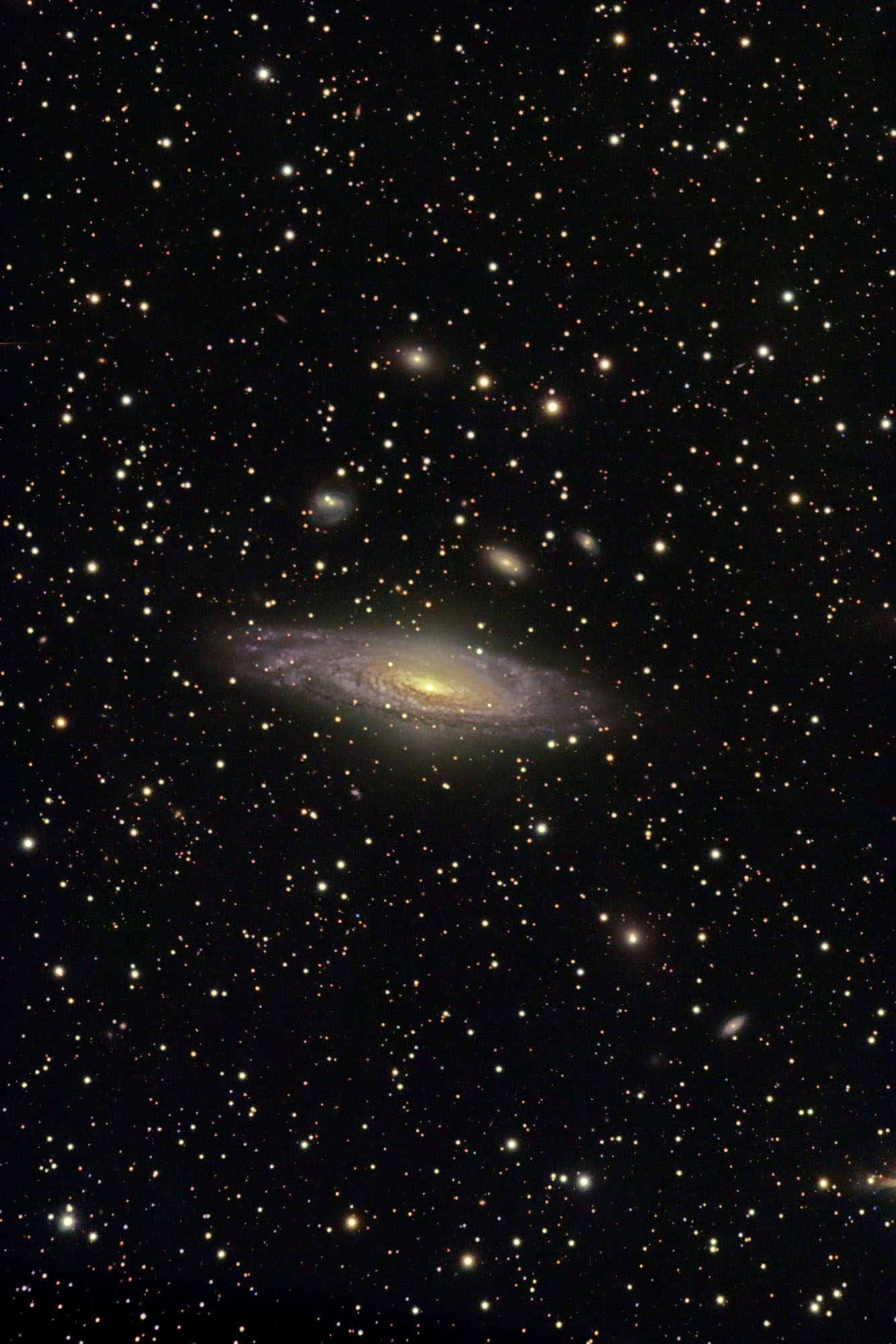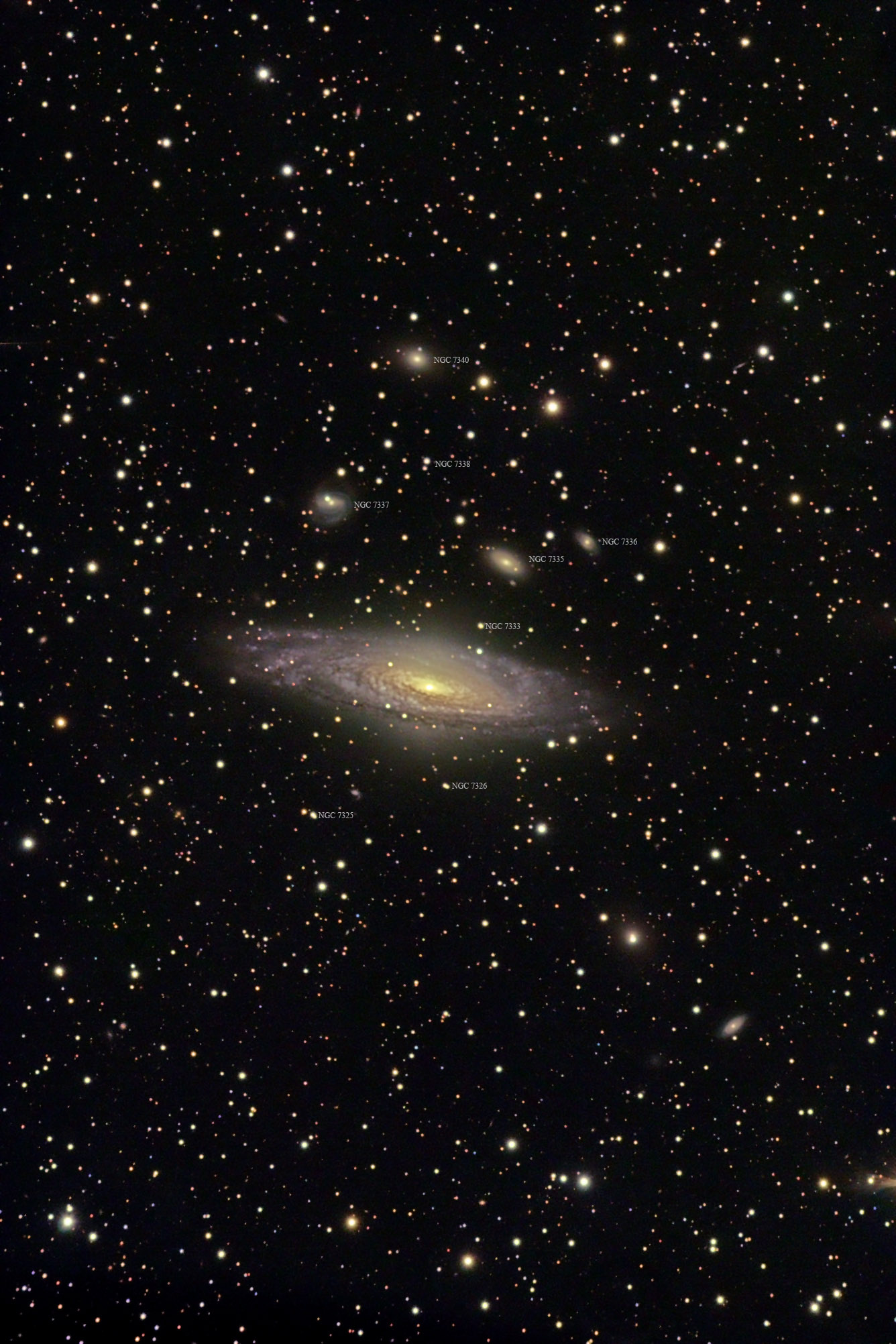| Description | Images |
Object name: NGC7331Designation(s): NGC7331, NGC7333, NGC7335, NGC7336, NGC7337, NGC7325, NGC7326, The Deer Lick Group is anchored by NGC 7331. Normally I show my shots with north up. The disk of the main galaxy NGC 7331 is strongly warped. Seen with north up this warp wasn't as obvious as it is rotated with east up. Our minds prefer to see spiral galaxies flat like a plate rather than on end. So I gave in and rotated it. The main galaxy is NGC 7331. But there's no end of confusion to the NGC objects around this guy. Some sources consider NGC 7325 and 7326 as two double stars below (west) of NGC 7331 and NGC 7327 the elliptical galaxy straight below the right edge of NGC 7331. It is almost hidden by a bright star below it. Other sources consider this to be NGC 7325 with NGC 7326 being the spiral down and to the right of it. But then these sources consider 7327 to be the same object as 7325! There are yet other ways of assigning these three NGC numbers. Now that's confusing. And you thought astronomers had all this figured out. Related Designation(s):1RXS J223705.9+342519, 1WGA J2237.0+3424, 2MASS J22370406+3424567, 2MASS J22371940+3426523, 2MASS J22372190+3428543, 2MASS J22372663+3422274, 2MASX J22370410+3424573, 2MASX J22371935+3426525, 2MASX J22372186+3428545, 2MASX J22372663+3422275, 2MASXi J2237218+342854, 2MASXi J2237266+342226, 2XMM J223704.3+342459, 2XMM J223719.2+342652, 2XMMp J223719.2+342651, 87GB 223447.1+340906, 87GB[BWE91] 2234+3409, AGC 320279, BMW-HRI J223718.9+342654, CGCG 2234.8+3410, CGCG 2235.0+3412, CGCG 2235.1+3407, CGCG 514-068, CGCG 514-069, CGCG 514-071, CXO J223704.0+342455, CXO J223704.04+342456.0, GALEXASC J223648.44+342202.3 , GALEXASC J223651.95+342524.6 , GALEXASC J223719.38+342653.1 , GALEXASC J223721.61+342854.9 , GALEXASC J223726.53+342227.8 , GALEXMSC J223648.38+342201.9 , GALEXMSC J223651.95+342523.3 , GALEXMSC J223719.39+342651.9 , GALEXMSC J223721.96+342853.2 , GALEXMSC J223726.40+342227.0 , HDCE 1198 NED005, HDCE 1198 NED006, HOLM 795A, HOLM 795B, HOLM 795C, HOLM 795F, HOLM 795H, HOLM 795I, HOLM 795J, IRAS 22347+3409, IRAS F22347+3409, ISOSS J22370+3426, LDCE 1520 NED054, LDCE 1520 NED055, LDCE 1530 NED003, LGG 459:[G93] 003, MAPS-PP O_0778_0998251, MAPS-PP O_0778_0998393, MCG +06-49-045, MCG +06-49-047, MCG +06-49-049, MCG +06-49-050, MG3 J223706+3425, NGC 7325, NGC 7326, NGC 7331, NGC 7331:[L2011a] X0003, NGC 7331:[RW2000] X-01, NGC 7333, NGC 7335, NGC 7336, NGC 7337, NGC7325, NGC7326, NGC7331, NGC7333, NGC7335, NGC7336, NGC7337, NPM1G +34.0449, NPM1G +34.0450, NSA 149966, NSA 149970, NSA 149972, NSA 149974, PGC 069327, PGC 069337, PGC 069338, PGC 069344, RX J2237.0+3425, SDSS J223704.05+342456.8, SDSS J223726.63+342227.4, SSTSL2 J223648.45+342201.2, SSTSL2 J223651.92+342524.1, SSTSL2 J223652.07+342520.6, SSTSL2 J223711.61+342613.9, SSTSL2 J223719.37+342652.8, SSTSL2 J223721.90+342854.4, UGC 12113, UGC 12116, UGC 12120, USGC U818 NED02, USGC U819 NED05, UZC J223704.5+342501, UZC J223719.4+342652, VLSS J2237.0+3424, WBL 684-001, WBL 684-002, WBL 684-003, [BTW2003] J2237+3424, [GMM2009b] 79, [SLK2004] 1798, [SRC98] 01, [SRC98] 02, [WB92] 2234+3407 NED02, |

